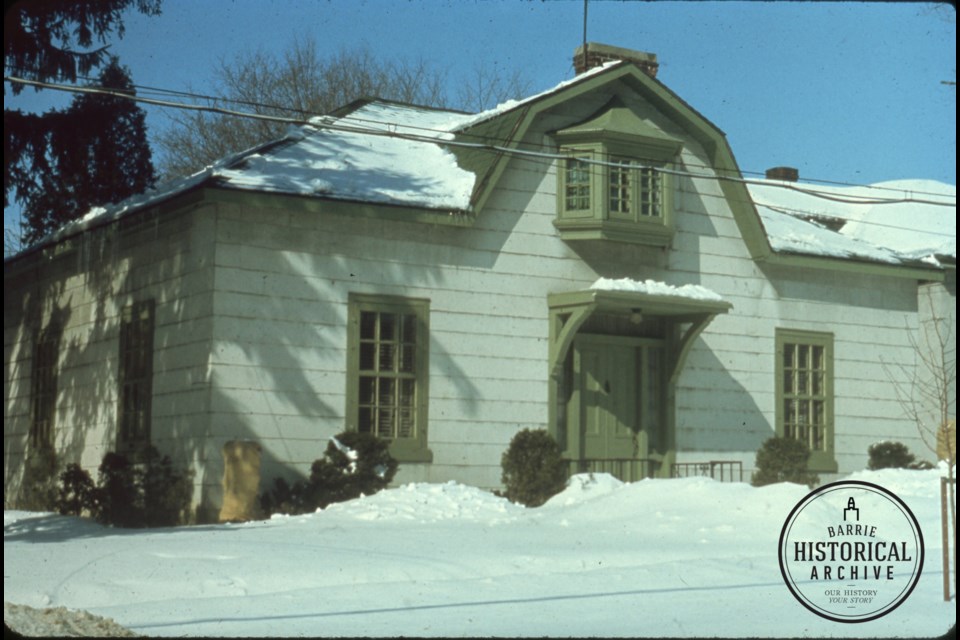This ongoing series from Barrie Historical Archive curator Deb Exel shows old photos from the collection and one from the present day, as well as the story behind them.
79 Toronto St.
Robert Ross was one of five men who comprised the School Committee of Barrie.
The group approached the government in 1834, seeking land to build a school for the growing number of children in the Town of Barrie. Their request for Lot 74, at the northwest corner of Collier and Owen streets, was granted.
Later, in 1837, the Vespra Township Board of Commissioners was formed and, in 1838, Ross became one of the three Barrie officials on the board. Barrie and its school were part of Vespra until 1854.
Ross was also an officer of the Lake Simcoe Boat Club in 1855, originally founded as the Barrie Regatta Club in 1846.
He lived at 79 Toronto St., or at least until he sold the home to Moses Hayter.
Hayter, who was a grocer, left England in 1832 for Big Bay Point, Innisfil Township, by way of New York, then York (Toronto). Once in Innisfil, Hayter met David Soules, one of the earliest area pioneers, and Soules’s brother-in-law, Samuel Lount.
The Hayters did not have much means, and the Souleses helped the family out as much as they could for several months. Eventually, Hayter turned to Lount for assistance, and it was given. Hayter never forgot this benevolence and valued Lount’s friendship. It also made him an unfaltering supporter of Lount’s family when Lount was later accused of treason and hanged following the 1837 Rebellion.
In 1843, when Hayter was appointed the first jailer of the Simcoe District, he and his wife moved to Barrie. He resigned from this position in 1852, after his wife, Elizabeth, had been knocked unconscious when a prisoner made a grab for the jail keys.
Hayter bought a farm in Vespra Township in 1855 — 15 acres near Grove Street, between Duckworth and St. Vincent streets — and in 1859, he bought the Ross house on Toronto Street, keeping the farm as well. Hayter died five years later, followed by his wife a few months after that.
The Hayter home was sold to Rev. William Thornley about 1879. Thornley was born about 1838 in Leicestershire, England. His family came to Canada when he was seven, settling first in Thornhill, then moving to New Jersey and back to Canada again.
Thornley spent 49 years in the ministry, serving on many circuits including appointments in Innisfil and the Elizabeth Street Church in Barrie, just a few doors down from 79 Toronto St.
Another minister would follow. Rev. William Fraser (another Bill) would reside in the Toronto Street home until his death in the early 1890s.
In 1895, the Myers family moved in. William (yes, another Bill) was born in 1834 at Burlington Quay, Yorkshire, England. His father, Dr. W.S. Myers, moved to Canada that same year, locating in Thornhill and sending for his family to join him three years later. Bill started a shoe business in Richmond Hill, married Emma Sanderson and together they had five children.
The Myers family moved to Barrie in 1877, and Bill set up his shoe business on Dunlop Street East, just west of where the CIBC is located. His son, H.B., eventually took over the shoe store from his father. Emma Myers outlived her husband by many years, as well as her son, who had taken over the family business.
When Mrs. Myers died at the age of 98, she was the oldest member of Collier Street United Church. Her funeral was held at her nephew’s house at 22 Peel St., the former home of Mayor Radenhurst.
The little regency-style cottage at 79 Toronto no longer has its six-over-six sash windows, or the charming little eight-pane ones in the oriel window of the gambrel roof’s centre gable, but the old Ross house is still recognizable today.



